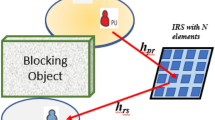Abstract
The imperfect spectrum monitoring (SM) is a major obstacle to detect the emergence of primary user (PU) quickly during the cognitive users’ (CUs’) data transmission which results data-loss and introduces the interference at PU. The cooperation in CUs for SM is an effective solution to improve its performance. Therefore, in this paper, a scenario, where CUs can cooperate with each other for SM is presented and have analyzed the effect of cooperation on various performance metrics namely, the data-loss, interference efficiency, and energy efficiency. An algorithm is illustrated for the computation of data-loss under various conditions of the traffic intensity of PU and probability of SM error. Moreover, the closed-form expressions of these metrics are derived for the cooperative and non-cooperative SM. Further, the simulation results are presented for various scenarios of traffic intensity, probability of SM error and channel gain between the CUs’ transmitter to PU receiver. Furthermore, the Monte-Carlo simulation results are exploited to consider the random nature of the PUs’ traffic intensity as well as to support the numerically simulated results.





Similar content being viewed by others
Notes
Assumption: The perfect SM system is very quick and ideal, even though a particular packet is required to compute decision statistics.
The subscript NCM represents the non-cooperative spectrum monitoring
The subscript CM represents the cooperative spectrum monitoring.
References
Haykin, S. (2005). Cognitive radio: Brain-empowered wireless communications. IEEE Journal on Selected Areas in Communication, 23(2), 201–220.
Mitola, J., & Maguire, G. Q. (1999). Cognitive radio: Making software radio more personal. IEEE Personal Communication, 6(4), 13–18.
Zhao, Q., & Sadler, B. M. (2007). A survey of dynamic spectrum access: Signal processing, networking, and regulatory policy. IEEE Signal Processing Magazine, 24(3), 79–89.
Alkyldiz, I. F., Lee, W.-Y., Vuran, M. C., & Mohanty, S. (2006). NeXt generation/dynamic spectrum access/cognitive radio wireless networks: A survey. Computer Networks, 50(13), 2127–2159.
Thakur, P., Singh, G., & Satashia, S. N. (2016). Spectrum sharing in cognitive radio communication system using power constraints: A technical review. Perspectives in Science, 8, 651–653.
Thakur, P., Kumar, A., Pandit, S., Singh, G., & Satashia, S. N. (2017). Advanced frame structures for hybrid spectrum accessing strategy in cognitive radio communication system. IEEE Communication Letters, 21(2), 410–413.
Christian, I., Moh, S., Chung, I., & Lee, J. (2012). Spectrum mobility in cognitive radio networks. IEEE Communication Magazine, 6(6), 114–121.
Thakur, P., Kumar, A., Pandit, S., Singh, G., & Satashia, S. N. (2017). Spectrum mobility in cognitive radio network using spectrum prediction and monitoring techniques. Physical Communication, 24, 1–8.
Boyd, S. W., Frye, J. M., Pursley, M. B., & Royster, T. C., IV. (2012). Spectrum monitoring during reception in dynamic spectrum access cognitive radio networks. IEEE Transactions on Communication, 60(2), 547–558.
Soltanmohammadi, E., Orooji, M., & Pour, M. N. (2013). Improving sensing-throughput trade-off for cognitive radios in Rayleigh fading channels. IEEE Transactions on Vehicular Technology, 62(5), 2118–2130.
Ali, A., & Hamouda, W. (2015). Spectrum monitoring using energy ratio algorithm for OFDM-based cognitive radio networks. IEEE Transactions on Wireless Communication, 14(4), 2257–2268.
Orooji, M., Soltanmohammadi, E., & Pour, M. N. (2015). Improving detection delay in cognitive radio using secondary-user receiver statistics. IEEE Transactions on Vehicular Technology, 64(9), 4041–4055.
Thakur, P., Kumar, A., Pandit, S., Singh, G., & Satashia, S. N. (2017). Performance analysis of high-traffic cognitive radio communication system using hybrid spectrum access, prediction and monitoring techniques. Wireless Networks. https://doi.org/10.1007/s11276-016-1440-7.
Thakur, P., Kumar, A., Pandit, S., Singh, G., & Satashia, S. N. (2017) Performance analysis of high-traffic cognitive radio network with imperfect spectrum monitoring technique. IEEE Sensors Journal (under review).
Xing, X., Jing, T., Cheng, W., Huo, Y., & Cheng, X. (2013). Spectrum prediction in cognitive radio networks. IEEE Wireless Communications, 20(2), 90–96.
Barnes, S. D., Maharaj, B. T., & Alfa, A. S. (2016). Cooperative prediction for cognitive radio networks. Wireless Personal Communications, 89(4), 1177–1202.
Jian, Y., & Hang-Sheng, Z. (2015). Enhanced throughput of cognitive radio networks by imperfect spectrum prediction. IEEE Communication Letters, 19(10), 1338–1341.
Thakur, P., Kumar, A., Pandit, S., Singh, G., & Satashia, S. N. (2017). Performance analysis of cognitive radio networks using channel-prediction-probabilities and improved frame structure. Digital Communication and Networks. https://doi.org/10.1016/j.dcan.2017.09.012.
Pandit, S., & Singh, G. (2015). Backoff algorithm in cognitive radio MAC protocol for throughput enhancement. IEEE Transactions on Vehicular Technology, 64(5), 1991–2000.
Kay, S. M. (1998). Fundamentals of Statistical Signal Processing: Detection Theory (Vol. 2). Englewood Cliffs: Prentice Hall.
Jiang, C., Zhang, H., Han, Z., Ren, Y., Leung, V. C. M., & Hanzo, L. (2016). Information-sharing outage-probability analysis of vehicular networks. IEEE Transactions on Vehicular Technology, 65(12), 9479–9492.
Akyildiz, I. F., Lo, B. F., & Balakrishnan, R. (2011). Cooperative spectrum sensing in cognitive radio networks: A survey. Physical Communication, 4(1), 40–62.
Mili, M. R., & Musavian, L. (2017). Interference efficiency: A new metric to analyze the performance of cognitive radio networks. IEEE Transactions on Wireless Communication, 16(4), 2123–2138.
Thakur, P., Kumar, A., Pandit, S., Singh, G., & Satashia, S. N. (2017). Performance analysis of SMC-MAC protocol for distributed cognitive radio networks. IEEE Transactions on Vehicular Technology (under review).
Chatterjee, S., Maity, S. P., & Acharya, T. (2016). Energy efficiency in cooperative cognitive radio network in the presence of malicious users. IEEE System Journal. https://doi.org/10.1109/jsyst.2016.2631219.
Karmokar, A., Naeem, M., & Anpalagan, A. (2015). Green metric optimization in cooperative cognitive radio networks with statistical interference parameters. IEEE System Journal. https://doi.org/10.1109/jsyst.2015.2451996.
IEEE 802.22 Standard, May 2005. [Online]. http://www.ieee802.org/22/.
Acknowledgements
The authors are sincerely thankful to the editor and anonymous reviewers for their critical comments and suggestions to improve the quality of manuscript. The authors are also grateful to Indian Space Research Organization (ISRO) vide project no. ISRO/Res/4/619/14-15 for financial aid.
Author information
Authors and Affiliations
Corresponding author
Rights and permissions
About this article
Cite this article
Thakur, P., Kumar, A., Pandit, S. et al. Performance analysis of cooperative spectrum monitoring in cognitive radio network. Wireless Netw 25, 989–997 (2019). https://doi.org/10.1007/s11276-017-1644-5
Published:
Issue Date:
DOI: https://doi.org/10.1007/s11276-017-1644-5




